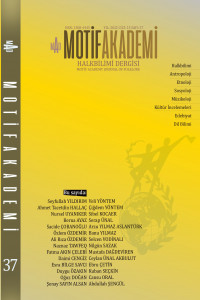CEM SULTAN’IN CEMŞÎD U HURŞÎD’İ ÇEVİRME NEDENLERİNE DAİR BİR DEĞERLENDİRME: EJDERHAYI ÖLDÜREN KİM?
SOME THOUGHTS ON WHY CEM SULTAN CHOSE TO TRANSLATE THE CEMŞÎD U HURŞÎD: WHO KILLED THE DRAGON?
Author(s): Sibel KocaerSubject(s): Regional Geography, Turkish Literature, The Ottoman Empire, Translation Studies
Published by: Motif Halk Oyunları Eğitim ve Öğretim Vakfı
Keywords: Cem Sultan; Cemşîd u Hurşîd; Saltuknâme; Shahnama; dragon;
Summary/Abstract: The Ottoman Sultan Cem (d. 1495), who is well-known worldwide, almost beat the rival to the throne, but failed. However, compared to other Ottoman princes, he was the closest to victory. Although he was prevented from ascending the throne, through his character, charisma and achievements he gained the support of those around him and was accepted as sultan by his supporters. Because of this, he is the only Ottoman prince who can claim the title ‘Sultan’. After the death of his father Mehmed II (d. 1481) his life changed dramatically with the start of his years in captivity. His captivity had a major effect on the political agenda of both the Ottoman State and European kingdoms. This article focuses on the Âyât-ı Uşşâk (1478) by Cem Sultan, which is the Turkish translation of the Cemşîd u Hurşîd by Selmân-ı Sâvecî (d. 1376). The original work is in Persian, and the translated work is also referred to as Cemşîd u Hurşîd in academic studies. Cem Sultan was the governor of the Konya and Karaman region when he translated the Cemşîd u Hurşîd. Owing to his great interest in literature, he was often accompanied by an admiring group of poets, and some of them accompanied him during his stay in Europe as well. Cem Sultan was also the patron of the Saltuknâme (1473-1480), which closely mirrors the political events of its time. The fact that he translated the Cemşîd u Hurşîd, at a time when he was trying to strengthen his power amidst political struggles and wars, makes this work stand out and thought provoking. This article will examine Cemşîd u Hurşîd with a particular focus on the princely identity of its translator, Cem Sultan. Unlike the original work, its translation includes a separate chapter on the killing of the dragon by Cemşîd, and it consists of 41 couplets. Looking closely at the episode on the killing of the dragon, which was rewritten by Cem Sultan, this article addresses the possible reasons why an Ottoman prince should choose to translate the Cemşîd u Hurşîd.
Journal: Motif Akademi Halkbilimi Dergisi
- Issue Year: 15/2022
- Issue No: 37
- Page Range: 222-235
- Page Count: 14
- Language: Turkish

